>Here are our four-point X-oriented star blocks so far. Click on the small icons to go directly to the block.
Spider Web
 Spider Web (three colors) Spider Web (three colors)
 Spider Web
Finley Spider Web
Finley
1929
 Spider Web (four colors) Spider Web (four colors)
Ruth Finley published this block in her 1929 book Old Patchwork Quilts. The block shares a name with several others, notably a six-sided scrap block that resembles either a Log Cabin or a string block, depending on how it's constructed. (It's a string block if all the fabric strips are sewn onto a separate backing; it's a log cabin if all the strips are sewn to each other.) |
|
ElectricFan, No. 2
 Electric Fan, No. 2 (half of blocks turned 180º) Electric Fan, No. 2 (half of blocks turned 180º)  Electric Fan, No. 2
Stone Electric Fan, No. 2
Stone
1906
Electric Fan, No. 2 is block #42 in the 1906 booklet Practical Needlework by Clara Stone. The graphic at left is traced from a photo of the original.
Oddly enough, the block is a five-patch (5 by 5 squares).
Ordinarily, a block requires an even number of squares in its grid to have a center point. Here, however, it is the width of the small dark triangles at upper right and left that determine the grid size. The center point comes from the lines drawn from the corners of those triangles. Weird, huh? The two darker triangles also pose some interesting possibilities for quilt layout.
For the first Electric Fan, click here:  |
|
Connecticut
                Connecticut Connecticut
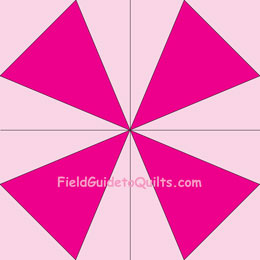 Connecticut
Hearth & Home Connecticut
Hearth & Home
 Connecticut in four colorsShoemaker's Puzzle/Block Island Puzzle Connecticut in four colorsShoemaker's Puzzle/Block Island Puzzle
It's never been clear to us how the word "Puzzle" could be attached to so many relatively simple blocks. Still, by any other name, Connecticut was, and is, a puzzle. Perhaps it is because in a whole quilt, the block forms the same pattern as Priscilla. To see Priscilla, click here: 
|
Kaleidoscope
                Kaleidoscope (Holstein) Kaleidoscope (Holstein)
 Kaleidoscope Kaleidoscope
Holstein
1973
Either way, both blocks are ever so slightly different in proportions to Hall's Semi-Octagon from 1935 ( below). |
|
Semi-Octagon
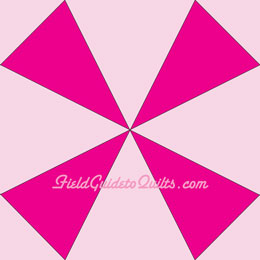 Semi-Octagon
Hall Semi-Octagon
Hall
1935
The oldest of this block's names is Semi-Octagon, from the mid-1930s, when Carrie Hall included it among her collection of quilt blocks now at the University of Kansas' Spencer Museum of Art.
Will o' the Wisp (a "delusive or elusive goal," per Merriam-Webster) came along in 1945, in Farm Journal & Farmer's Wife. Finally, the Kansas City Star came up with The Windmill Blades in 1954. It's drawn on a 12 by 12 grid, which makes it ever so slightly different in proportions from Holstein's Kaleidoscope.
|
|
Block Island Puzzle
                Block Island Puzzle Block Island Puzzle
 Block Island Puzzle Block Island Puzzle
Quilters' Newsletter Magazine #66.
Quilters' Newsletter Magazine as its #66, according to Barbara Brackman. Brackman cites Hearth & Home for the names of the Connecticut block, above. Like Connecticut, Block Island Puzzle has a parallel in a four-point star called Crossed Canoes. To see that block, click here: 
|
|
The Mayflower
 The Mayflower
Ladies World Magazine, The Mayflower
Ladies World Magazine,
1893
First published in Ladies' World Magazine in 1893, The Mayflower was republished in 1933 in the Detroit Free Press; Nancy Page, the columnist, called it Mayflower Quilt. It was also in Nancy Cabot's Chicago Tribune column in 1934 as Mayflower. The block has four quarter-blocks with a five-sided patch in each. In drawing up this graphic, we followed the lead of quilt designer Jinny Beyer, whose Quilter's Album of Patchwork Patterns describes it as a block of 14 by 14 squares.
|
|
Oklahoma's Square Dance
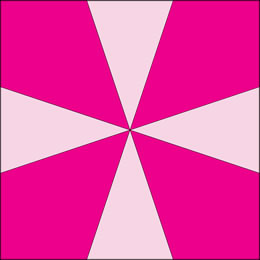 Oklahoma's Square Dance
Kansas City Star, 1942 Oklahoma's Square Dance
Kansas City Star, 1942
The block shows why we don't separate propeller shapes into X and plus blocks: This one could be either.
|
|
Maltese Cross
 Maltese Cross in two colors Maltese Cross in two colors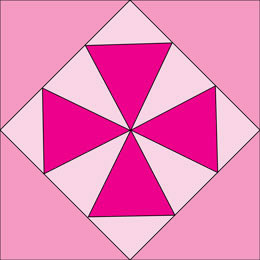
Maltese Cross
Ladies Art Co., #272
1897 Maltese Cross in three colors Maltese Cross in three colors
The Ladies Art Company published this block as its #272 in 1897. Nancy Cabot, when it was published in 1935 in the Chicago Tribune, called it Iron Cross.
The Ladies Art Company's Maltese
Cross shape is a variation of St. George's Cross, which is usually a straightforward plus (+) shape.
|
|
Double Z
                Double Z Double Z
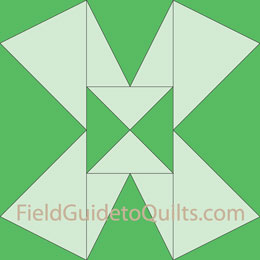 Double Z
Louisville Farm & Friends Double Z
Louisville Farm & Friends
1883
                         Double Z with alternating colors Double Z with alternating colors
The LAC's second Double Z, #360, apparently didn't catch on the way #192 did, because #360 goes by the name the LAC gave it. Both are drawn on 6x6 grids. See the other, called Brown Goose, here: 
Double Z is in fact older than the LAC's 1897 catalog. It appeared in an 1883 Louisville Farm and Friends, according to Beyer's Quilter's Album of Patchwork Patterns.
|



